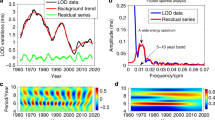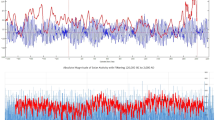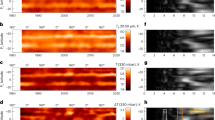Abstract
Historical records suggest that during the seventeenth century the Sun was subject to an anomalous scarcity of sunspots (the Maunder minimum1). This minimum was coincident with a severe temperature dip of the Little Ice Age2, from which a relation between solar activity and terrestrial climate has been conjectured3. Solar variability is also suggested by the regular variations in the thickness of annual laminae or 'varves' in the late Precambrian formation in south Australia4. The climatic cycles recorded by the varves include the present 10–12-year solar cycle as well as deep minima, with a mean period of 314 years. A natural explanation of the solar cycle climate connection would be a modulation of the solar output radiation, and possibly a change of the solar diameter5,6. By analysing a unique 53-year record of regular observations of the solar diameter and sunspot positions during the seventeenth century, we have shown for the first time that the solar diameter was larger and rotation slower during the Maunder minimum. This finding sheds new light on the dynamo mechanism, solar variability, and the consequent effects on terrestrial climate.
This is a preview of subscription content, access via your institution
Access options
Subscribe to this journal
Receive 51 print issues and online access
$199.00 per year
only $3.90 per issue
Buy this article
- Purchase on Springer Link
- Instant access to full article PDF
Prices may be subject to local taxes which are calculated during checkout
Similar content being viewed by others
References
Maunder, R. W. Knowledge 5, 173 (1894).
Thompson, L. G., Mosley-Thompson, E., Dansgaard, W. & Grootes, P. M. Science 234, 361–364 (1986).
Eddy, J. A. Science 236, 92 (1975).
Williams, G. E. Aust. J. Phys. 38, 1027–1043 (1985).
Livingston, W. C. Nature 272, 340–341 (1978).
Spiegel, E. A. & Weiss, N. O. Nature 287, 616–617 (1980).
King, H. C. in The history of the Telescope 98–100 (Dover, New York, 1979).
Delambre, J. B. Histoire de l'Astronomic Moderne tome 2, livre XV, 627 (Courcier, Paris, 1821).
Auzout, A. Phil. Trans. R. Soc. 21, 373 (1667).
Townley, R. Phil. Trans. R. soc. 25, 457 (1667).
Picard, J. Arch. Obs. Paris D1, 14–16 (1666–1682).
La Hire, Ph. Archs Obs. Paris, manuscripts D2, 1–10 (1683–1719).
Ephemeris of the Bureau des Longitudes (Gauthier-Villars, Paris, 1985).
Debarbat, S. Colloque Picard (1982) (ed. CNRS, in the press).
Tondu, A. Arch. Obs. Paris D5, 43 (1778).
Danjon, A. & Couderc, A. Lunettes et Télescopes, 27 (Blanchard, Paris, 1983).
Parkinson, J. H., Morrison, L. V. & Stephenson, F. R. Nature 288, 548 (1980).
Wittman, A. Sol. Phys. 66, 223–231 (1980).
Auwers, A. Astr. Nachr. 128, 361–365 (1891).
Dunham, J. B., Dunham, D. W. & Fiaia, A. D. Bull. Am. astr. Soc. 12, 832 (1980).
Delache, Ph., Laclare, F. & Sadsaoud, H. Nature 317, 416–417 (1985).
Balthasar, H., Vasquez, M. & Wohi, H. Astr. Astrophys. 155, 87–98 (1986).
Eddy, J. A., Gilman, P. A. & Trotter, D. E. Sol. Phys. 46, 3–14 (1976).
Abarbanell, C. & Wohl, H. Sol. Phys. 70, 197–203 (1981).
Gilman, P. A. in The Sun as a Star (ed. Jordan, St) 231–252 (CNRS, France and NASA Washington DC, 1981).
Duvall, T. L. & Harvey, Pomerantz, M. A. Nature 321, 500–501 (1986).
Ribes, E., Mein, P. & Mangeney, A. Nature 318, 170–171 (1985).
Ribes, E. C. hebd. Séanc. Acad. Sci., Paris 302, II, 871–876 (1986).
Cassini, J. D. Mem. Acad. Sci., Paris X, 727–731 (1730).
Shapiro, I. I. Science 208, 51 (1980).
Gilliland, R. L. Astrophys. J. 248, 2144–2155 (1981).
Eddy, J. A. & Boornazian, A. A. Physics Today 32, 17–21 (1979).
Leroy-Ladurie, E. in Histoire du Climat depuis l'an 1000 (Flammarion, Paris, 1967, republication 1983).
Howard, R. & Labonte, B. J. Astrophys. J. 239, L33–L36 (1980).
Snodgrass, H. B. & Howard, R. Sol. Phys. 95, 221–228 (1985).
Ribes, E. in Cospar Proceedings 11 (eds Noyes, R & Praderie, F.) (Pergamon, Oxford, in the press).
Author information
Authors and Affiliations
Rights and permissions
About this article
Cite this article
Ribes, E., Ribes, J. & Barthalot, R. Evidence for a larger Sun with a slower rotation during the seventeenth century. Nature 326, 52–55 (1987). https://doi.org/10.1038/326052a0
Received:
Accepted:
Published:
Issue Date:
DOI: https://doi.org/10.1038/326052a0
This article is cited by
-
Monitoring the Solar Radius from the Royal Observatory of the Spanish Navy since 1773
Solar Physics (2016)
-
The Solar Rotation in the Period 1853 – 1870 from the Sunspot Catalogues of Carrington, Peters, and de la Rue
Solar Physics (2015)
-
The Maunder Minimum and the Sun as the Possible Source of Particles Creating Increased Abundance of the 14C Carbon Isotope
Solar Physics (2010)
-
Solar Rotation During the Period 1847 – 1849
Solar Physics (2010)
-
Solar Rotation in the 17th century
Solar Physics (2006)
Comments
By submitting a comment you agree to abide by our Terms and Community Guidelines. If you find something abusive or that does not comply with our terms or guidelines please flag it as inappropriate.



